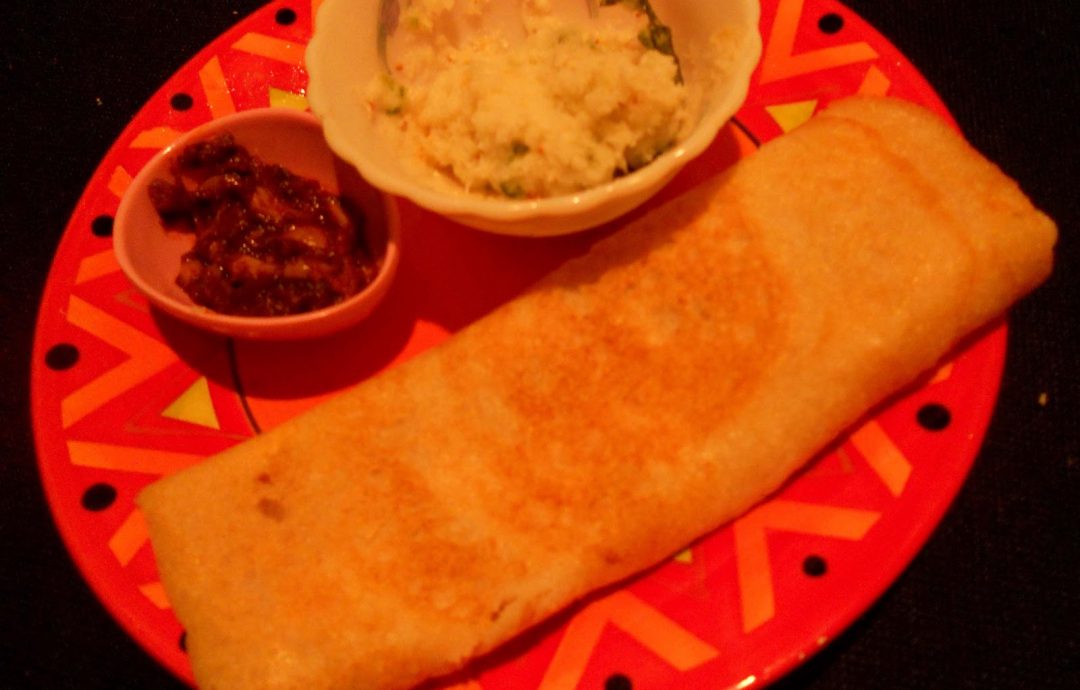
How to make Dosa Batter
On April 5, 2013 by Meghalee Das
Dosas are crepes made of fermented rice and lentils, either with or without a filling. Although they originated in South India, dosas are very popular in every part of the country, where people eat it either as a main course or also for breakfast. The basic dosa filling mainly consists of curried smashed potato, but there are many restaurants which offer a wide range of options like Paneer Dosa, Cheese Dosa and I have also eaten Chicken Keema Dosa in my hometown. The most important part of making dosa is getting the batter right; after that you can use any filling and get different types of dosas. Moreover, the dosa batter can also be used to make Utthapams, which are thicker crepes, like pancakes, with different types of toppings instead of fillings, and then roasted on a pan with a little oil.
It can be difficult to ferment the batter in cold climates. In India, you just leave it overnight, and next morning it doubles in size and you can have fluffy dosas for breakfast. But you have to start preparing 1 to 2 days in advance in colder regions. And the weather in Austin is pretty crazy; it can be freezing one day and very hot the next two days. I actually check the weather forecast before I make dosas here and ferment it for at least one whole day! There are many suggestions I found on the internet to accelerate the fermentation process:
— Keep it in the oven with the light switched on (I don’t have the option to switch on just the light in my oven, so never tried it)
— Preheat the oven at the lowest setting for a few minutes. Then keep the batter inside the oven. (I will probably try it, but I am scared that it will start cooking and fail!)
— Keep it in the microwave with the light switched on (I did that in my old apartment but didn’t notice much of a difference)
— Add a little yeast (DON’T! I once added yeast and although it did ferment and have a tangy taste, I didn’t feel like I was eating dosas)
— If your house is centrally air-conditioned, leave it outside during summer months. This works the best and I leave it covered in the patio or the storeroom.
 |
|
| Fermented dosa batter |
Another problem we face here is that it is difficult to get a wet grinder. Since I make dosas very rarely, I do not feel like investing in a proper grinder. But if you make it frequently, it is a very good idea to buy one. The first few times I used a blender, but one day the blender just stopped working! I was about to make Palak Paneer for some guests and had everything ready and then it wouldn’t work! There was a huge mess, no time and I had to use finely chopped spinach instead of a puree. Now I have a good food processor, but even that doesn’t work as perfectly as wet grinders like we have at home. The only thing you can do to ease the grinding process and not damage the motor is to soak the rice and the lentils for at least 10 hours or more, so that they are soft. The rice especially stays hard and does not get ground well in such blenders. Soak them well, grind on pulse mode the first few times with very little water and gradually increase the speed and amount of water. The result should be a slightly runny, a little granular batter.
The basic ratio of the rice and lentils is 2:1.
— For soft dosas, use a few more tbsp of lentils.
— For crispy dosas, use a small amount of chickpeas, which will also give it a nice golden colour
Prep Time: 10 hours+10-24 hours for fermentation Cooking time: 3-5 min per dosa Makes: 10-12
Ingredients:
Long-grained rice: 2 cups
Split black gram without skin or urad dal: 1 cup
Methi or Fenugreek seeds: 2 tsp
Chickpeas or Chana dal: 3 tbsp
Cooked rice or Ponni Boiled Rice: 1/2 cup (Optional)
Salt to taste
Method:
1) Soak the rice in one bowl and the lentils and methi in another and leave overnight.
2) Grind the lentils and rice separately with a little water till it becomes a smooth paste.
3) Mix them and add more water so that you get a flowing consistency. The texture need not be totally fine, it’s ok if it is slightly granular.
3) Pour in a large bowl or saucepan, cover and let it ferment for 10-24 hours in a warm place till the batter almost doubles in size and becomes frothy.
4) Add salt to taste. Keep any unused batter in the fridge so that you can make utthapams the next day.
I will post the recipes of different dosas, utthapams, idlis and chutneys in subsequent posts.
(Read how to use this batter to make plain dosas here http://meghs-kitchen.blogspot.com/2013/04/plain-dosa.html)




